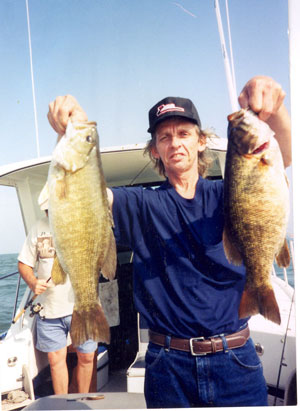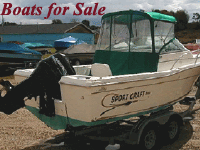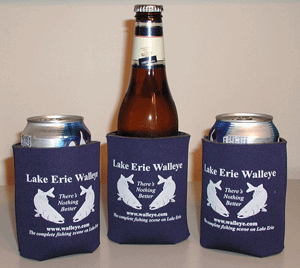|
Dog Days Bronzebacks
by Capt. Phil Cadez
The Western Basin of Lake Erie averages only 23
feet deep.  In August the water temperature can and will go over 75 degrees when
thereís high pressure areas holding, the water will become very warm.
Those ďdog daysĒ as theyíre called can make it very tough to have good
walleye fishing. A few ardent anglers and some charters get great
fishing action when they switch to deep water smallmouth fishing.
In August the water temperature can and will go over 75 degrees when
thereís high pressure areas holding, the water will become very warm.
Those ďdog daysĒ as theyíre called can make it very tough to have good
walleye fishing. A few ardent anglers and some charters get great
fishing action when they switch to deep water smallmouth fishing.
Many fishermen feel that, pound for pound,
smallmouth will out-fight any freshwater fish. His tenacity to never
give up makes him a prize for sportfishermen. Landing a five-pound
bronzeback, or jumper, as they are called, can really put a smile on any
anglerís face. Smallmouth are called jumpers because of their ability
to leap high into the air to try to spit the hook.
Smallies usually spawn in late May, then seek
shelter in deeper rocky places near their favorite food. As the water
warms they sometimes school deep dropoffs, rock piles or breaks in
structured bottom. This is when the jumpers are the easiest to catch.
Because of water nearing 80 degrees, jumpers might
go to 25 feet or even 35 feet in depth. A fish locator is an anglerís
best friend when it comes to finding submerged structure suitable for
bronzeback action. Live bait fished near the bottom is probably the
best way to fish. Tube jigs, Power Grubs and salt tube jigs with
heavier leadheads will work it itís calm and your drift is slow. The
tackle used usually consists of light spinning or baitcasting
combinations. Rods are usually short, but firm, 5 to 5-1/2 feet in
length with graphite composition.
Open faced spinning reels are spooled with size 6
to 8 pound test monofilament line. Spider Wire and Fire Line are also
becoming more popular. A Ĺ ounce egg sinker with a hole through the
center is threaded up the line. You can use a swivel on a 24 inch
leader with a hook on the end, or use a split shot placed on the line
approximately 24 inches away from the hook. Either way you hook up this
rig, it will keep the slip sinker away from the bait. A number 24 or 26
center drought Mustad hook tied securely to the end of the line is the
most preferred rig.
If the wind is slight, and the drift is slow, you
can locate the right depth by dragging soft craws or leeches near the
bottom. If the drift speeds up, use heavier slip sinkers. Some anglers
have the bait set and set the hook early while others open the bail and
let the fish go with the bait. Either method works providing the fish
has the bait securely in its mouth.
When youíre sure the fish has the bait, set the
hook and hold on. Soft craws are the best bait and are sold in local
bait shops for approximately $5.00 per dozen. Make sure you have at
least three to five dozen per person, because sheepshead also love this
tasty bait. Hook the crawfish by the tail and try to keep it close to
the bottom.
If you have located the fish near some structure,
you might mark it with a buoy so you can keep drifting by it or you can
anchor on or near the honey hole. Anchor with a long line so that you
can change positions without starting the motor by taking in or letting
our more anchor line. When anchored, drop the crawfish to the bottom,
but keep the sinker 6 to 12 inches off the structure. Again, you can
set the hook early or, better yet, let the fish run with the bait. Set
your drags easy, or youíll break the line with the tension of these
fighting bronzebacks. If you find junk fish such as white perch or drum
hitting your bait, let out more line to change your position. Keep
moving until you start catching mostly jumpers. You might have to move
many times to find the right position. When you find it youíll know in
a hurry. Iíve seen 6 lines in the water with 5 fish on at a time.
Iíve put three fish in the net at the same time.
If you want to in on this super fishing, bring a
good sized boat or book a charter with an experienced local guide.
Bring a wide brimmed hat, lotís of sun block and lotís of water or
soda. Purchase a chart showing the Bass Islands and Canadian Islands.
Youíll need to get a license if fishing in Canada. It will cost you
$14.00 a day at West Dock on Pelee Island. You can call 1 800 BUCKEYE
or e mail me at
[email protected]. Good Fishin! |






 In August the water temperature can and will go over 75 degrees when
thereís high pressure areas holding, the water will become very warm.
Those ďdog daysĒ as theyíre called can make it very tough to have good
walleye fishing. A few ardent anglers and some charters get great
fishing action when they switch to deep water smallmouth fishing.
In August the water temperature can and will go over 75 degrees when
thereís high pressure areas holding, the water will become very warm.
Those ďdog daysĒ as theyíre called can make it very tough to have good
walleye fishing. A few ardent anglers and some charters get great
fishing action when they switch to deep water smallmouth fishing.